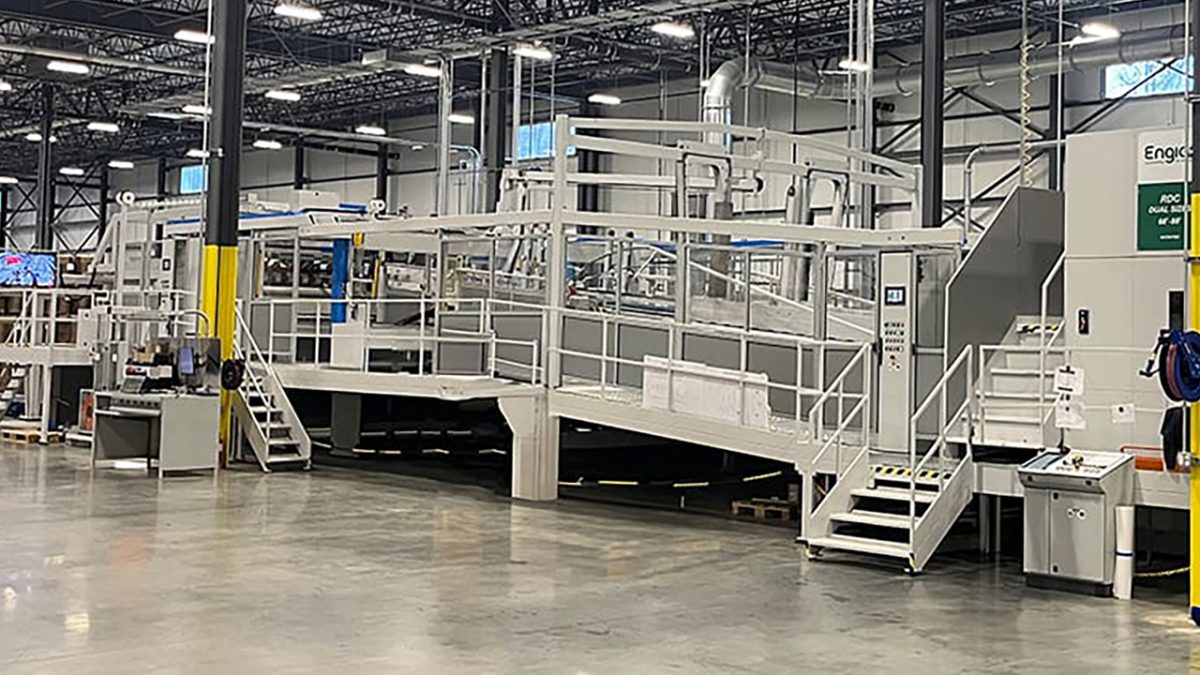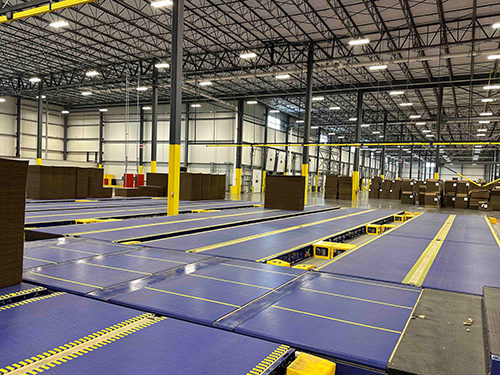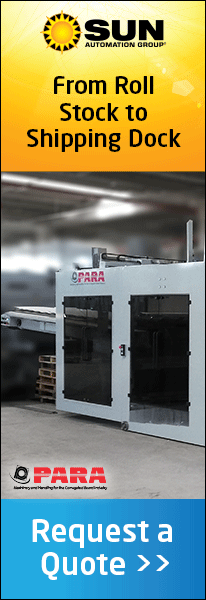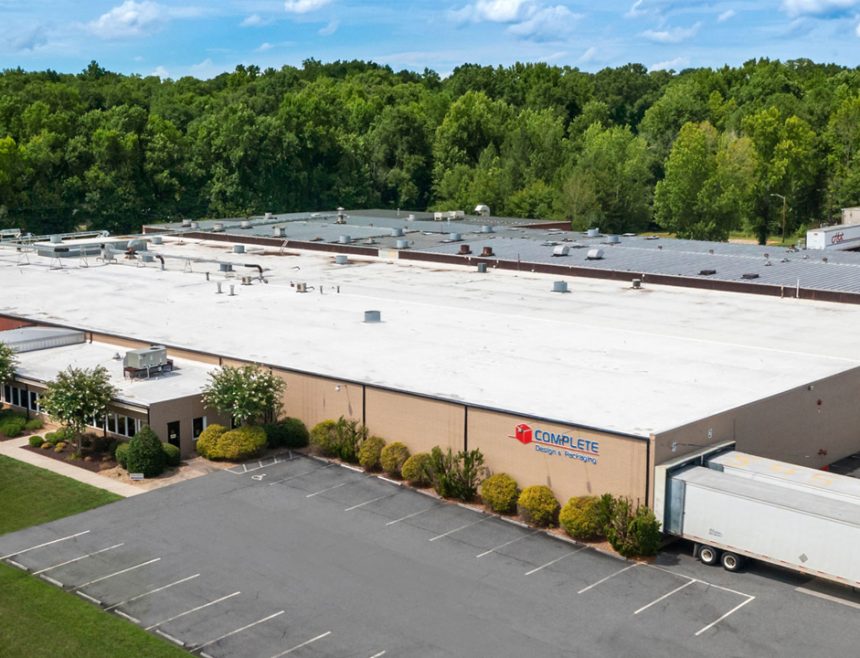An article by Len Prazych
The word greenfield evokes images of open land, a clean slate, a fresh start, and the incredible opportunities it often presents. As it pertains to business, a greenfield project is one that lacks constraints imposed by prior work on a particular site, that is, development on an entirely vacant site and completely from scratch, as opposed to a brownfield project, which does carry constraints related to the site’s current state. As it pertains to the corrugated industry, greenfield represents the foundational philosophy behind the construction and opening last year of Rand-Whitney’s newest 384,000 sq ft showpiece of a box plant in Boylston, MA, almost 40 miles west of Boston.
Rand-Whitney is an independent company owned by The Kraft Group. In the paper, packaging and forestry industries, the Group also owns mills, thus ensuring its paper supply in perpetuity and is considered an independent-integrated company. Its Boylston facility is Rand-Whitney’s fifth in the Northeast and was built a mere 12 miles from its Worcester facility, where the company’s roots date back to 1938.
One might think that the new facility in Boylston would be built to replace the infrastructure and product and service offerings of its nearby sister plant, but one would be mistaken.
A Dream Come True
“What we’re doing here in Boylston is a full complement to what we’ve been doing in Worcester,” says Adam Tominsky, General Manager. “We haven’t had to shut down any operations in this location or any others in the Northeast and in fact, we’ve leveraged our personnel, maintenance, and labor in Worcester to get us up to speed and producing at a high level here in our greenfield operation where everything – every piece of machinery in this building – from the ground up is brand new, which is a dream come true.”
Nick Smith, President/CEO, Rand-Whitney, adds, “The Krafts have given us the funds to build the newest and fastest car in the neighborhood and we’re beginning to see just how fast and far we can drive it. We’ll be running over two billion sq ft annually and we’ll be doing it with fewer than 60 people. We’re striving for complete efficiency and having the newest and best equipment definitely helps.”
Like kids in a candy store, Smith and Tominsky began filling the new facility to their heart’s desire. They began with an MHI EVOL 115 flexo folder gluer and a BW Papersystems G rotary die-cutter before dropping in a BHS Corrugated 2.8m corrugator. They purchased a second EVOL 115 and fitted both with Alliance Prefeeders, BW Papersystems Twin Box Slitters, and Alliance Robotic Load Formers.
The final piece of the machine family was a Jumbo flexo folder gluer by the Italian manufacturer Engico – represented by Merrilville, Indiana based Haire Group. It has dual-cylinder capability, a true 99-inches through the machine both for printing and for die-cutting. The machine is servo driven, so it provides a lot of flexibility in terms of what you’re printing what you’re cutting; it has the ability to run side slots and as well as slotted trays without a cutting die. It also offers the ability to glue and stitch in a single pass.
“Engico packaged several different machines into one, which was really intriguing and exciting to us because we don’t have to handle orders multiple times in multiple passes,” says Tominsky. “The other big thing that I like about the Engico is the innovation behind it. I think in our industry you don’t see a lot of innovation quickly. It takes time, usually five to 10 years, before something really new arrives to the market and to me, discovering the Engico was one of those innovative moments.”
Smith adds, “We really haven’t been directly involved in the jumbo business for about 10 years and we feel that the market has come a long way and we’re seeing a lot of opportunity out there. We’ve always had our hands in the jumbo business but we were outsourcing it. Having the Engico gives us a great reason to bring that business back in-house.”
News of the Engico Jumbo Flexo Folder Gluer came to Rand-Whitney’s attention not too far into the design of its new building about three years ago through Haire Group’s Keith Umlauf. “Keith intrigued us very quickly with the machine, its capabilities and the successes other converters were having with it. It was only a few months before we made the decision to buy one ourselves,” says Tominsky. “Since we had a greenfield site and the machine was a great complement to the rest of our plans, we decided to design the rest of the plant around it. We would be able to handle everything from small twin-box work all the way up to the biggest jumbo boxes.”
While the decision to invest in the Engico was made relatively quickly, Rand-Whitney’s management team did its due diligence. They visited Lawrence Paper Company in Lawrence, KS, already running their third Engico before making the commitment with Haire Group on their own machine for Boylston. “The reputation of this group was enough validation for me to justify our investment in the Engico,” says Tominsky. “Now we have people from other plants reaching out to us wanting to see it in operation.”
It wasn’t until the machine was just about ready to be broken down and be shipped from Engico’s manufacturing facility in Lissone, Italy, near Milan, that Tominsky traveled to witness the performance testing and demos. “We assigned five different jobs and we chose the specs while Engico built the tooling and ordered the board. We set some speed factors and determined our quality criteria and everything checked out perfectly. I think it was probably one of the shortest demos I’ve ever done. The Engico team was gracious, professional, and transparent throughout.”
No Operational Challenges
According to Smith, startup went great and Rand-Whitney in Boylston is already staffing for a second shift. There have been virtually no operational challenges. “Even though it’s got the one color on the 99-inch cylinder and two colors on the 66-inch cylinder, you can run it as a three-color machine. You’re not going to get the full 99-inch graphics on all three colors but you can use the two downs to create the effect of a of a second 99-inch cylinder.”
He adds, “We now have a Jumbo in our system and we’ve tethered it to a ‘beast of a corrugator’ in a massive facility, so unless you’re willing to make that kind of investment, it may not the right strategic decision for you. Once we laid the groundwork and put our plan in motion, we knew we were going to have mid-size flexos and die-cutters but we definitely knew we wanted a world-class Jumbo. We found it in the Engico.”
As one would expect with Rand-Whitney’s jumbo-sized undertaking in Boylston, the material handling WIP system is fully automated and boasts three autonomous transfer cars; after board comes off the corrugator – full-plan scheduling and interface is through Kiwiplan – there is no human contact with material until it arrives at the converting lines, all of which are operated by two-person crews.
With a sales force leveraging existing relationships with long-term customers, having the Engico has created more opportunities for new business, and with it, of course, more opportunities to invest in even more machinery. Smith again mentioned Haire Group and their relationship with Dong Fang and its innovative EDF material handling equipment off the Engico.“If you’re going to remain competitive in our industry, you’ve got to be investing,” concludes Smith. “If you’re not investing, it’s just a question of time before your competitor is and some point you’re at a disadvantage. We’re proud of what we’ve done here, what we’re continuing to do and we’re happy to have our competitors visit so they can see for themselves what’s possible. This plant is not only a show plant for Engico, but also for all the other vendors that helped us pull this together.”














